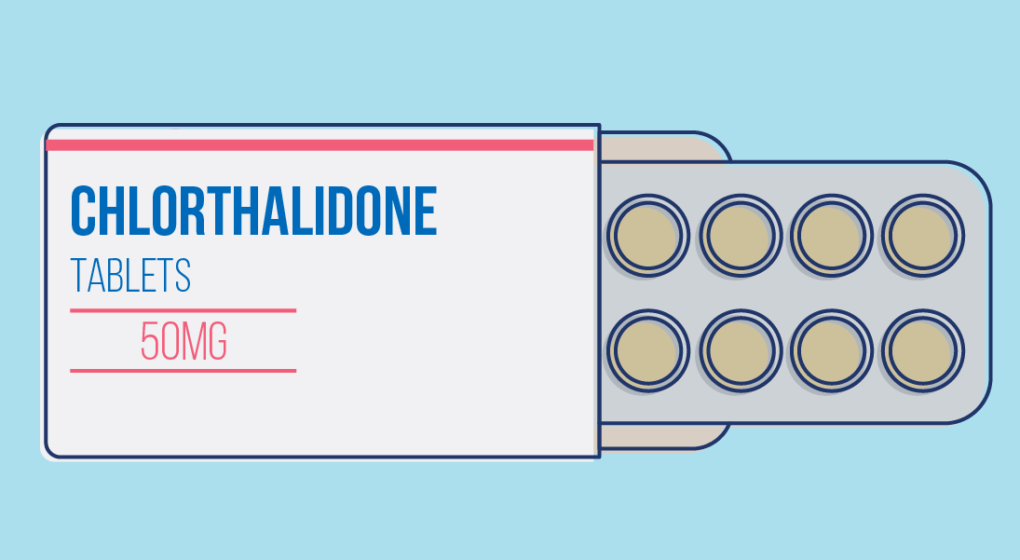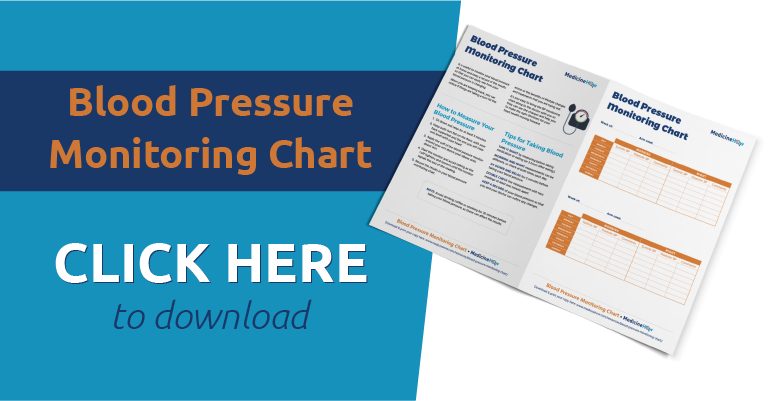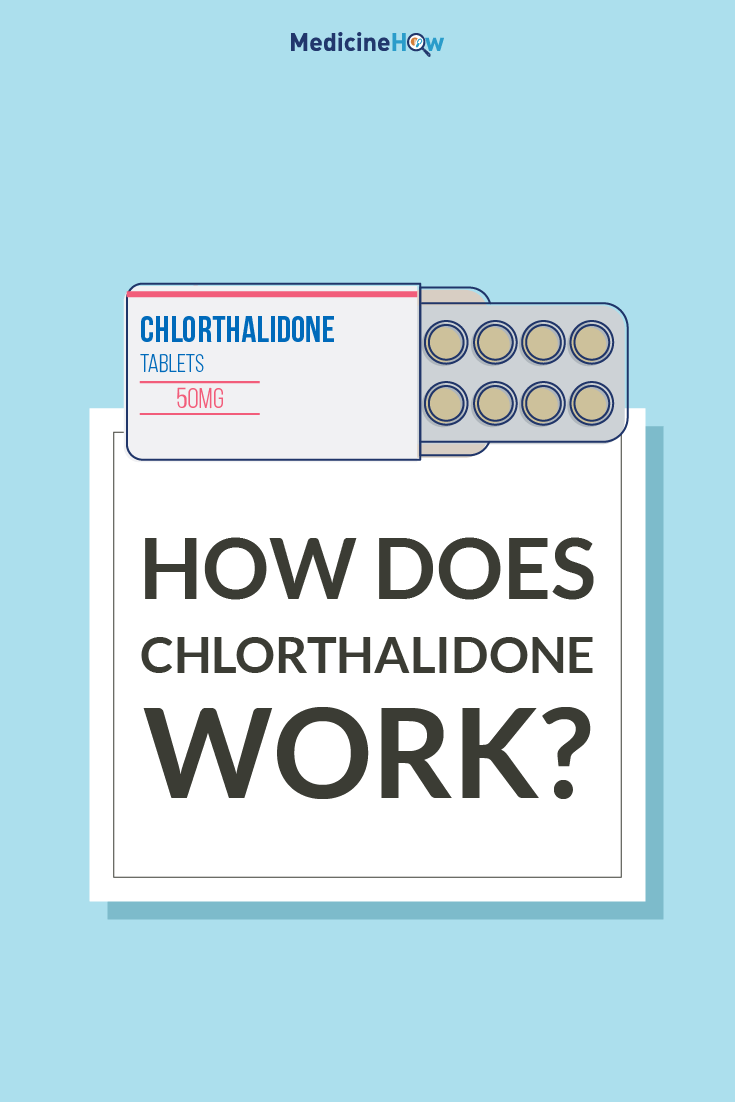
Chlorthalidone is a thiazide-related diuretic, which works by blocking sodium from being reabsorbed from your urine and into your blood, causing more sodium and water to be secreted from your body. It also helps the muscles around the blood vessels in your body to relax, allowing the blood to pass through more easily and lowering the pressure of the blood.
It is usually used to manage hypertension or to treat oedema related to heart failure.
Brand Names and Doses
![]() Chlorthalidone is generic name, which is the active drug found in the medication and it is the active ingredient in the medication brand name, Hygroton. It is available in a single dose of 25 mg.
Chlorthalidone is generic name, which is the active drug found in the medication and it is the active ingredient in the medication brand name, Hygroton. It is available in a single dose of 25 mg.
Most people find that it is best to take chlorthalidone in the morning, as it causes them to go to the toilet frequently, which can be frustrating at nighttime and inhibit sleep.

What type of drug is it?
![]() Chlorthalidone is a type of drug called a thiazide-related diuretic. Other medicines that are in the same class and work in a similar way are:
Chlorthalidone is a type of drug called a thiazide-related diuretic. Other medicines that are in the same class and work in a similar way are:
Other diuretics that have a slightly different mechanism of action are:
How does it work?
![]() Chlorthalidone changes the way your kidneys filter the blood to produce urine, leading to more fluid being excreted. It also has an effect to relax your blood vessels and lower blood pressure.
Chlorthalidone changes the way your kidneys filter the blood to produce urine, leading to more fluid being excreted. It also has an effect to relax your blood vessels and lower blood pressure.
In a healthy person, the nephrons in the kidneys are responsible for making urine and excreting waste products from your body. They constantly filter your blood, reabsorbing the “good” nutrients that your body needs back into your blood from the urine and letting the “unwanted” products be excreted in your urine.
When you take chlorthalidone, the reabsorption of sodium and chloride in the nephrons slows down, so that more is excreted in your urine than usual. This also causes more water to be secreted because the water “follows” where the sodium is in the body to maintain the right balance, and has an effect on the concentration of potassium and magnesium in the blood.
Chlorthalidone can cause the muscles that surround your blood vessels to relax, which allows the blood to pass through the expanded vessels more easily. As a result of this, the blood pressure decreases.
Side Effects
![]() Chlorthalidone has a range of effects on the body, and this can sometimes cause unwanted adverse effects. The most common and worrying effects are:
Chlorthalidone has a range of effects on the body, and this can sometimes cause unwanted adverse effects. The most common and worrying effects are:
Low blood pressure (hypotension)
When chlorthalidone is working too well, you can end up with low blood pressure, making you feel dizzy or weak. This often occurs when you first start taking the medication and then gets better after a few days. If you find your blood pressure is still too low after a week, your should check with your doctor that the dose is right for you.
Salt Imbalances
Chlorthalidone works its effect by stopping the sodium and chloride salts in the urine from being reabsorbed back into the bloodstream and body, but this can change the balance of salts in your body and lead to problems. It’s not just sodium and chloride that are affected, but a range of different salts:
- Low sodium levels (hyponatremia)
- Low potassium levels (hypokalemia)
- Low chlorine levels (hypochloremic alkalosis)
- Low magnesium levels (hypomagnesemia)
You can ask your doctor for a blood test if you’d like to check that your levels are normal.
Other Effects
You may also notice a range of other effects – see the medicine information leaflet for the full list – such as:
- Muscle cramps
- Frequent urination
- Abnormal glucose levels
Cautions
![]() There are a couple of things you should be aware of before you start taking chlorthalidone:
There are a couple of things you should be aware of before you start taking chlorthalidone:
Gout – Chlorthalidone increases the concentration of uric acid in the bloodstream, which can lead to causing gout. If you are prone to gout, an alternative medication may be a better choice.
Renal Impairment – Chlorthalidone is less effective and may cause harm if you have severe renal impairment, due to its effect on the kidneys and renal function.

Drug Interactions
 ACE Inhibitors + Chlorthalidone Interaction
ACE Inhibitors + Chlorthalidone Interaction
ACE inhibitors and chlorthalidone taken together may cause low blood pressure, particularly for the first few doses taken in combination. It is best to stop taking it for a few days when beginning to take a new ACE inhibitor drug.
Lithium + Chlorthalidone Interaction
Chlorthalidone can decrease the amount of lithium that is excreted from the body and increase the risk of side effects. This combination is not recommended unless the concentration can be closely monitored.
Loop Diuretic + Chlorthalidone Interaction
Taking a loop diuretic drug with chlorthalidone can increase the risk of renal impairment and upset the balance of salts in the blood, so it should only be used in small doses.
NSAID + Chlorthalidone Interaction
NSAIDs and chlorthalidone should not be used together unless the blood pressure, renal function and weight are closely monitored and the dose adjusted according to the results.
Pregnancy and Breastfeeding
![]() Chlorthalidone should not be used by women who are pregnant or planning to become pregnant, as it may upset the balance of salts in the blood and cause harm to the baby. It can be taken while breastfeeding, but only in low doses as small amounts of the drug is excreted in breast milk and may affect your baby. Although it is unlikely, chlorthalidone may also decrease milk production.
Chlorthalidone should not be used by women who are pregnant or planning to become pregnant, as it may upset the balance of salts in the blood and cause harm to the baby. It can be taken while breastfeeding, but only in low doses as small amounts of the drug is excreted in breast milk and may affect your baby. Although it is unlikely, chlorthalidone may also decrease milk production.
Pin it!


